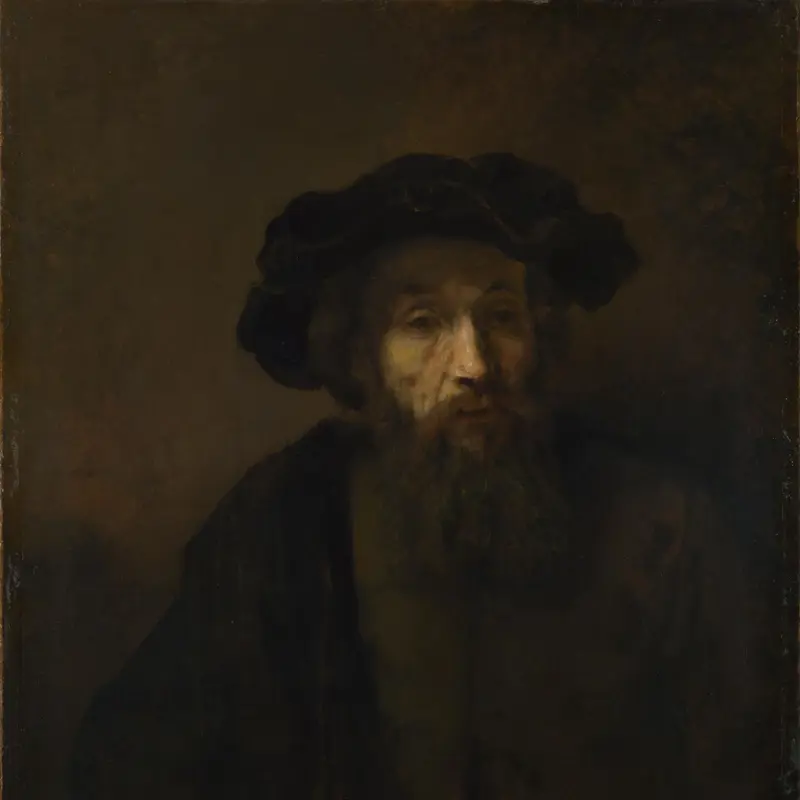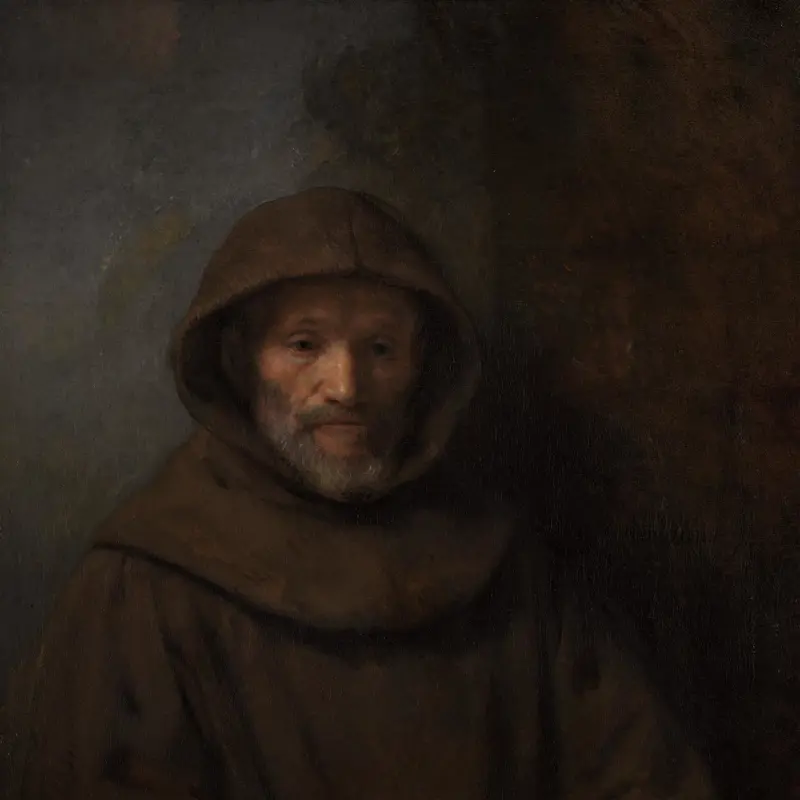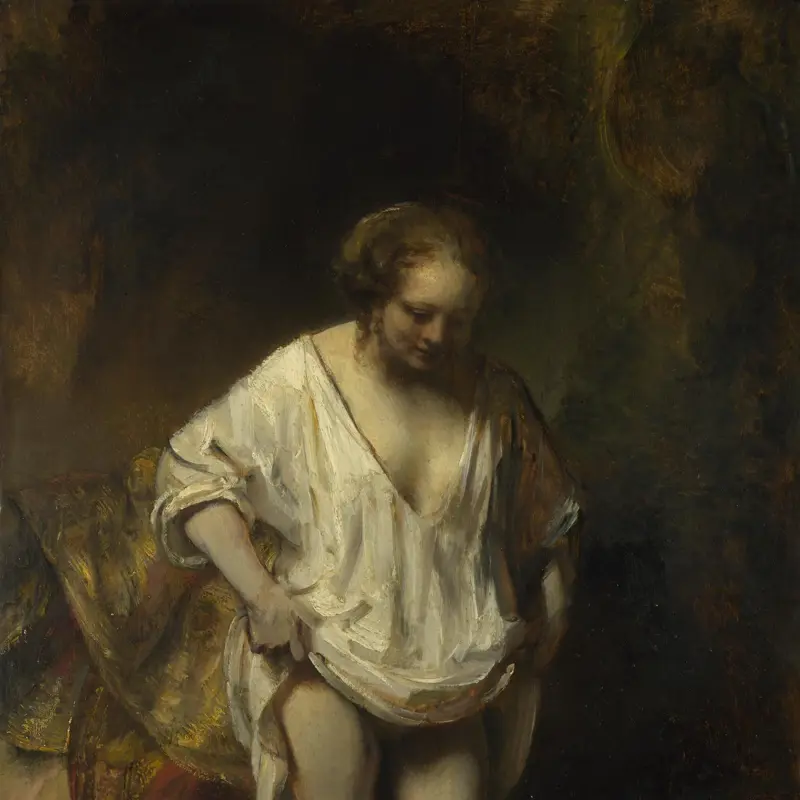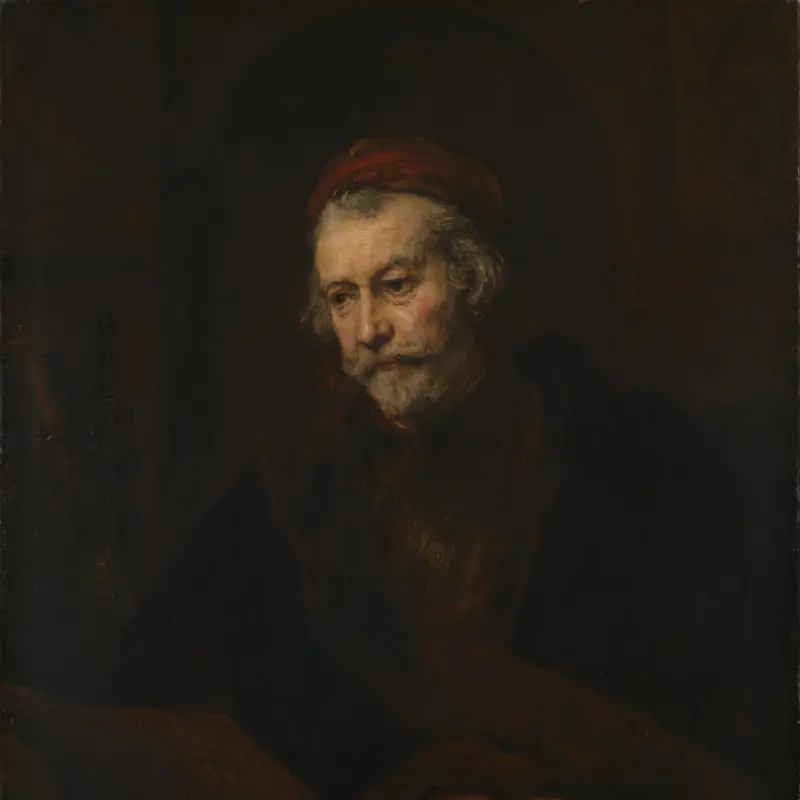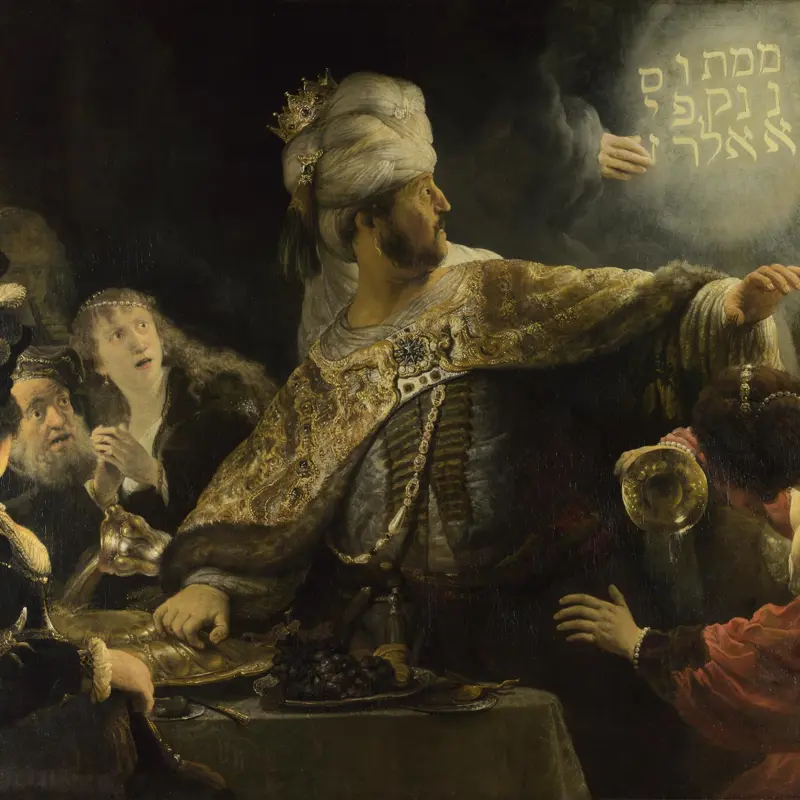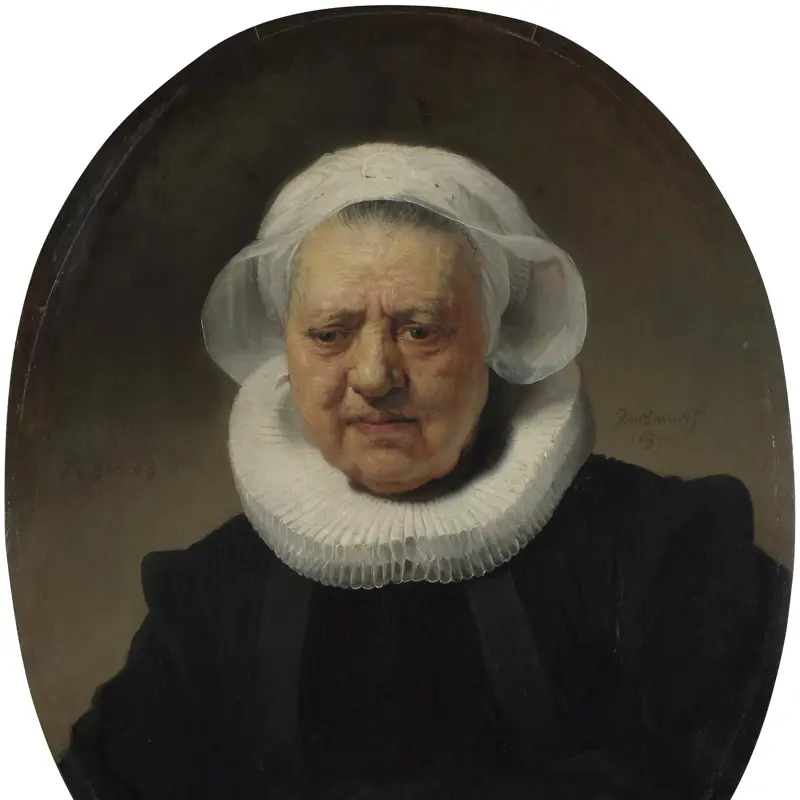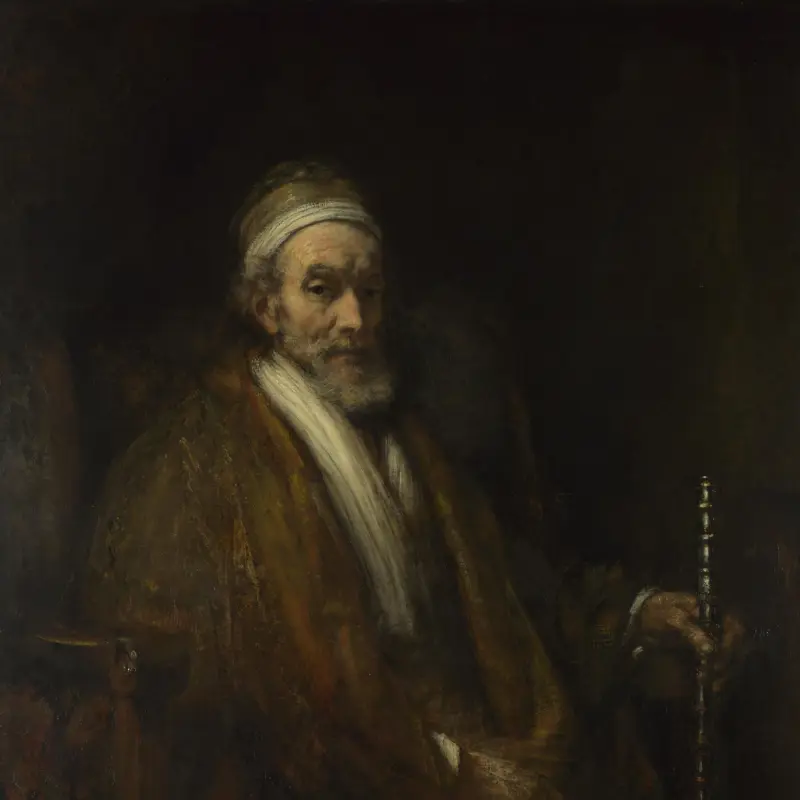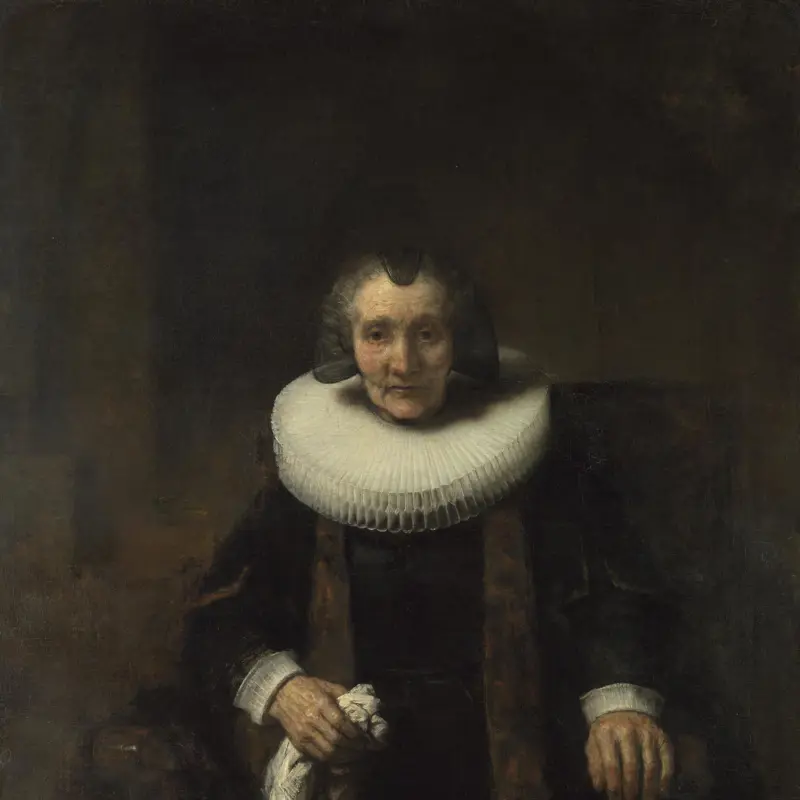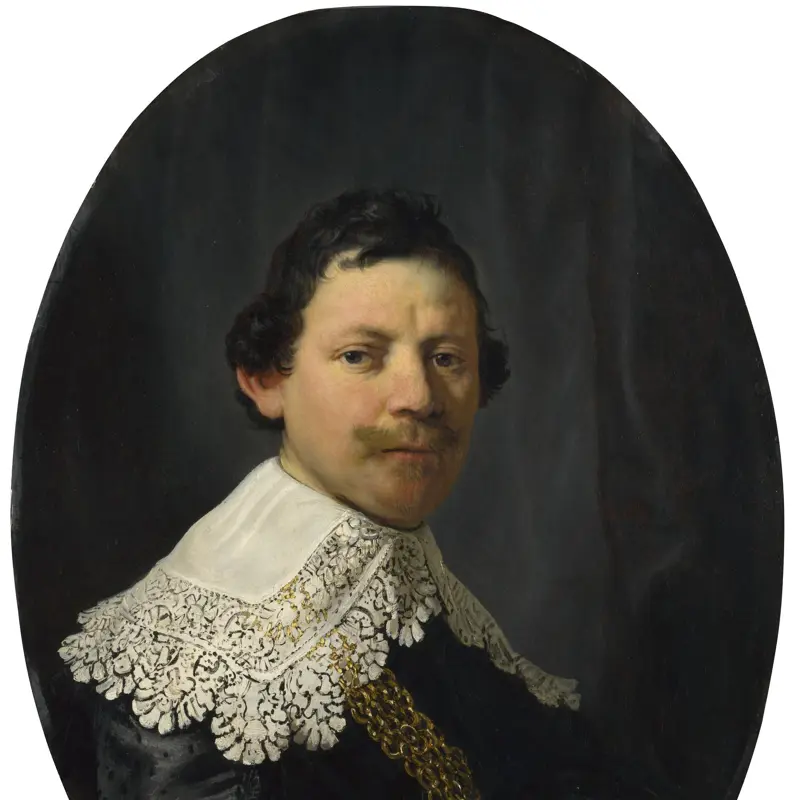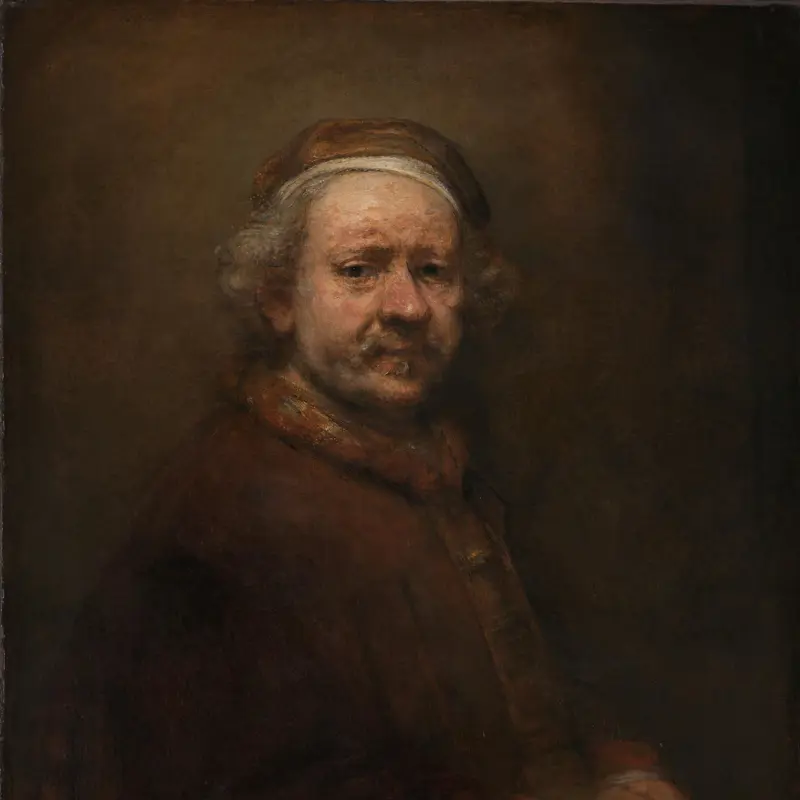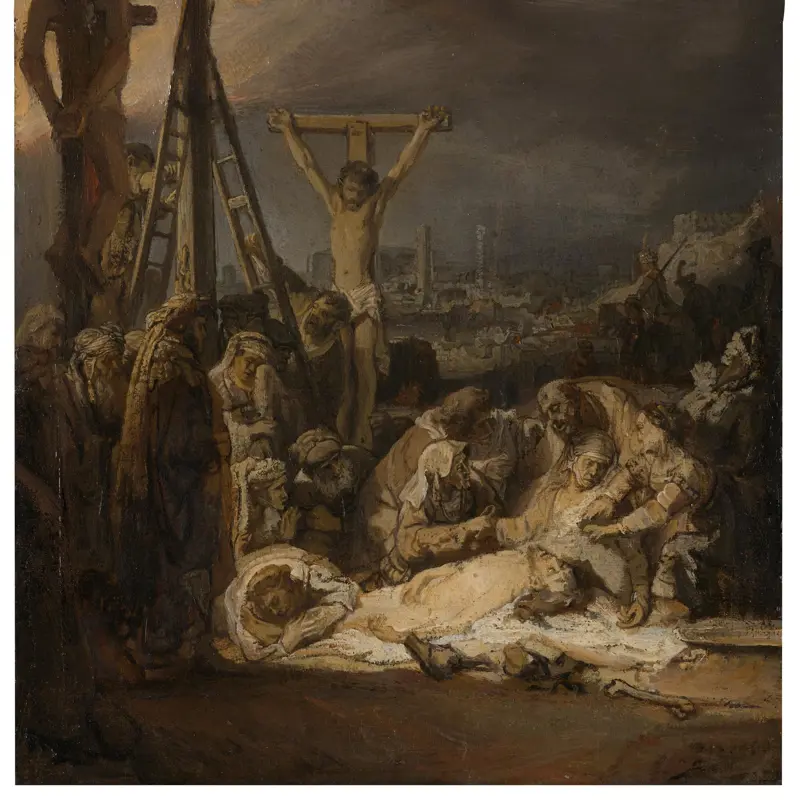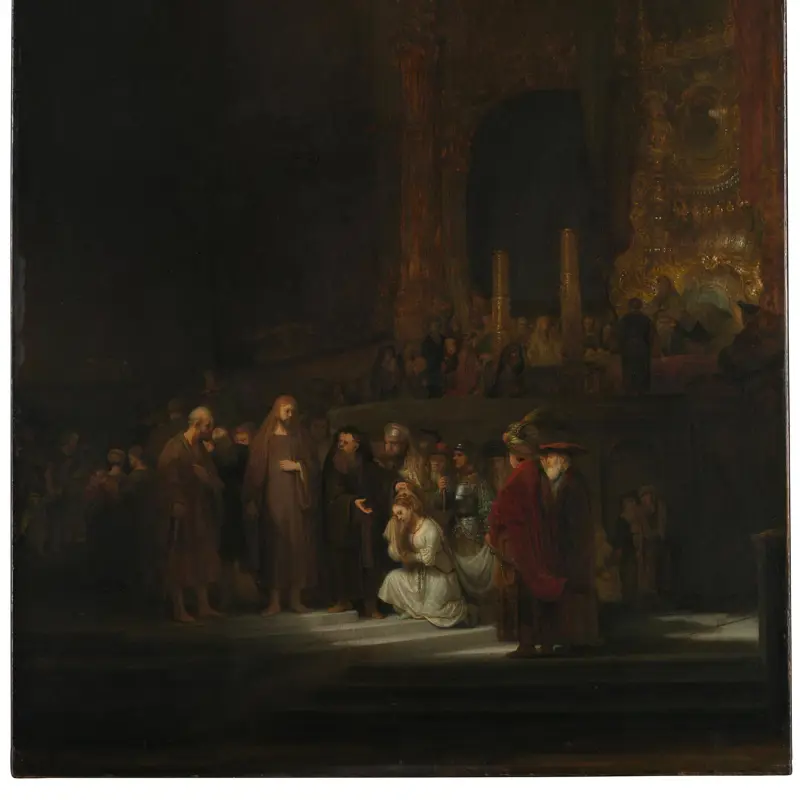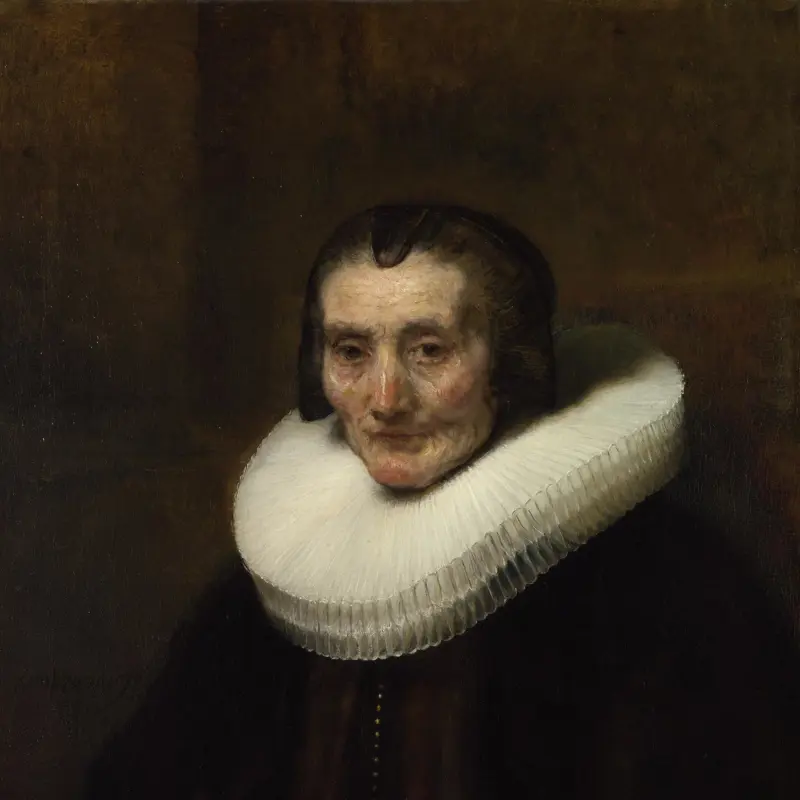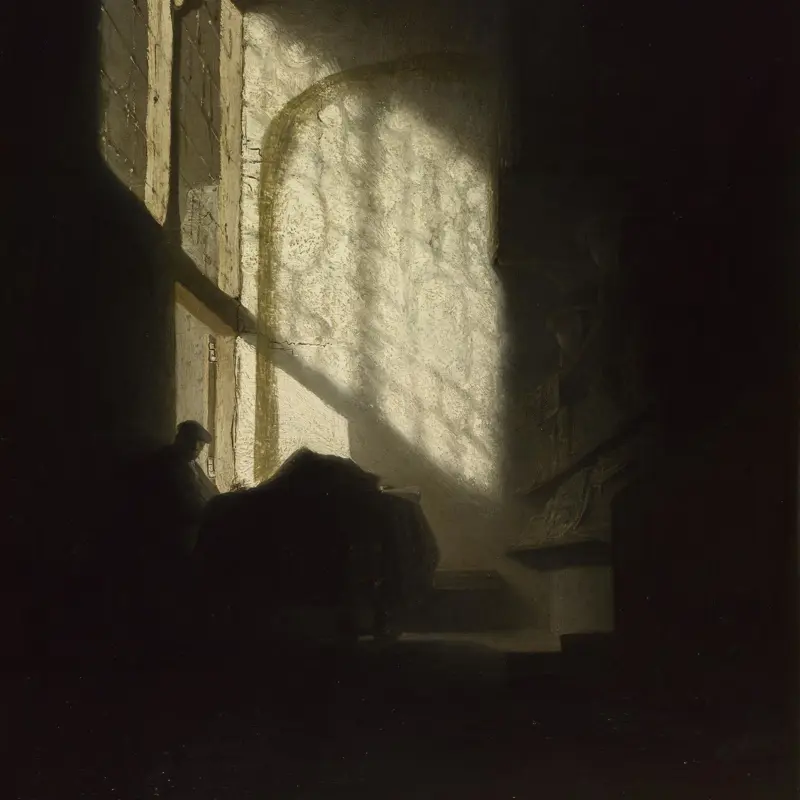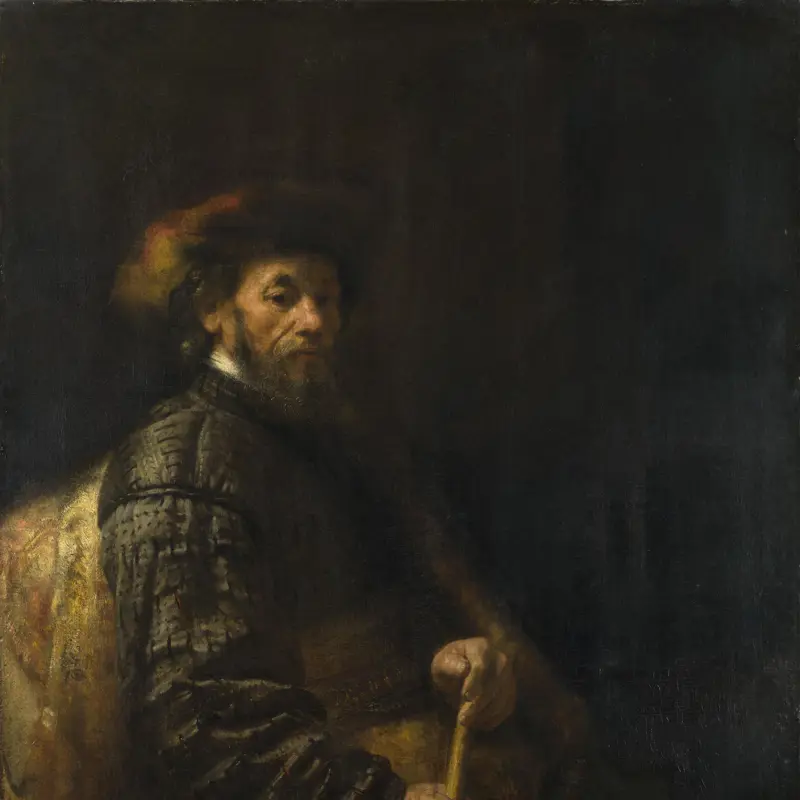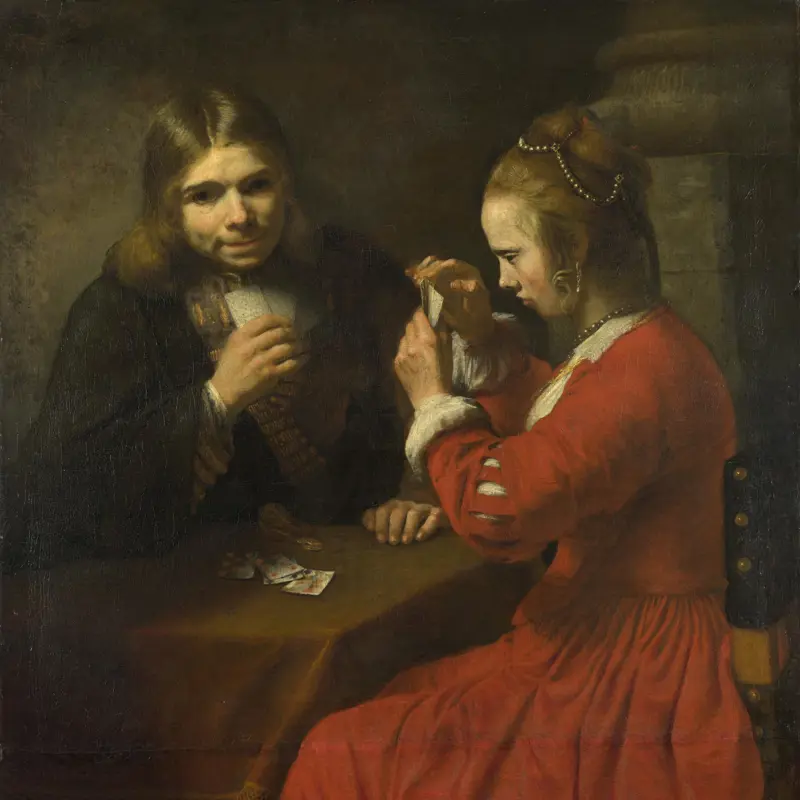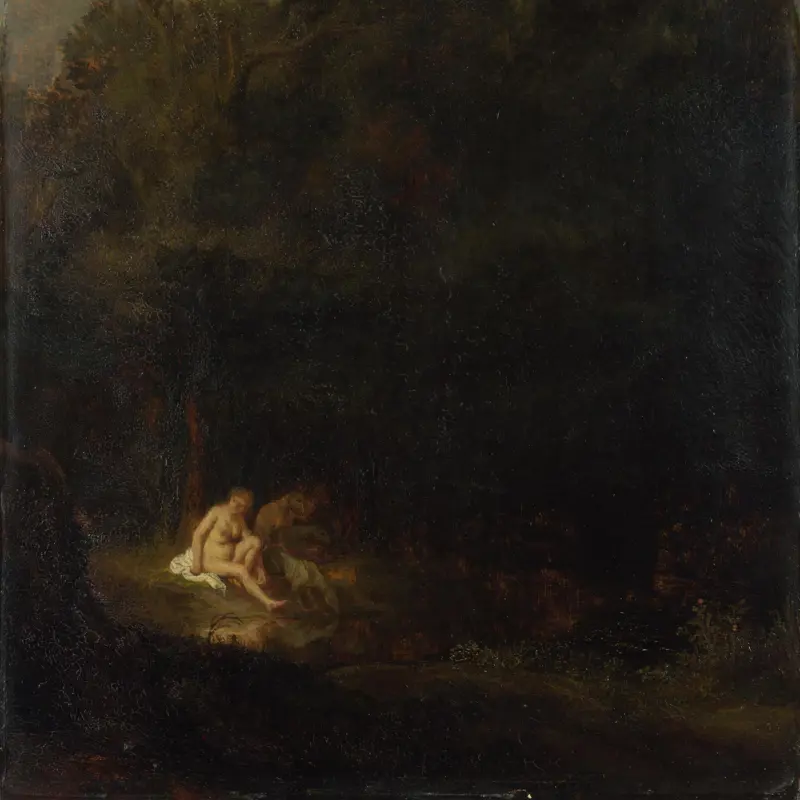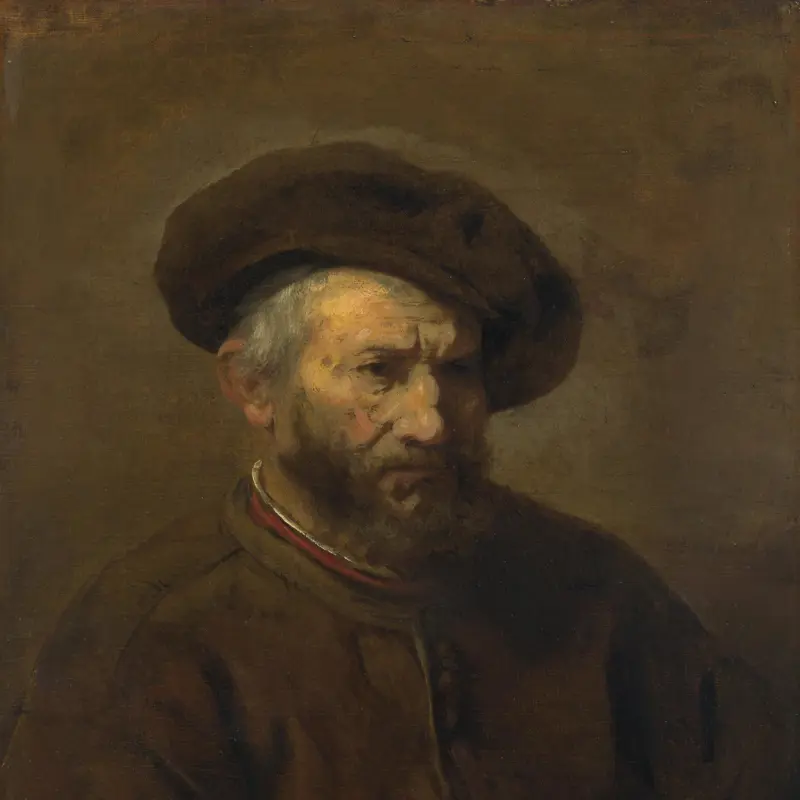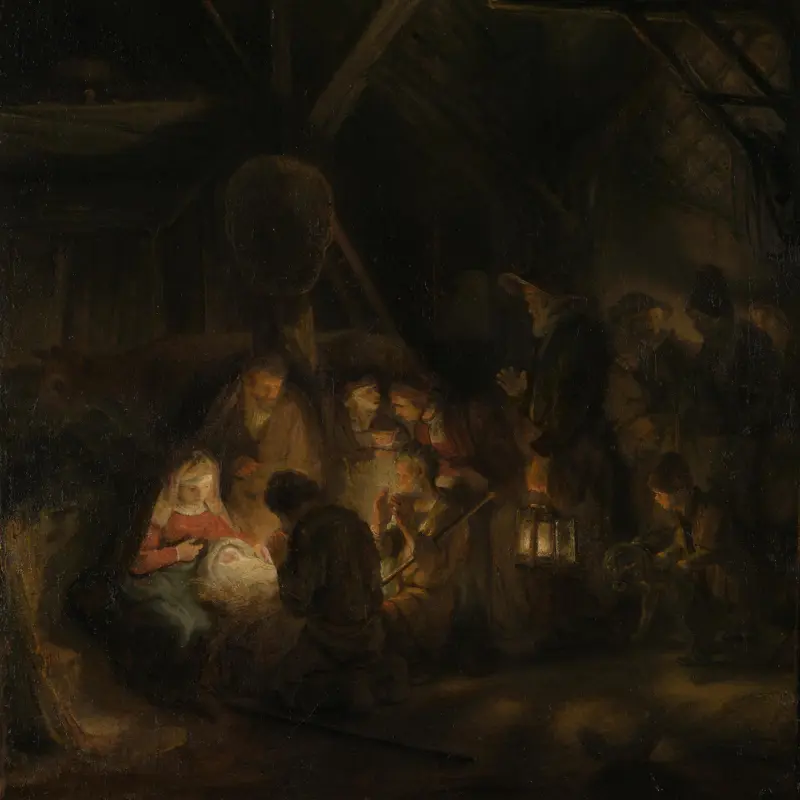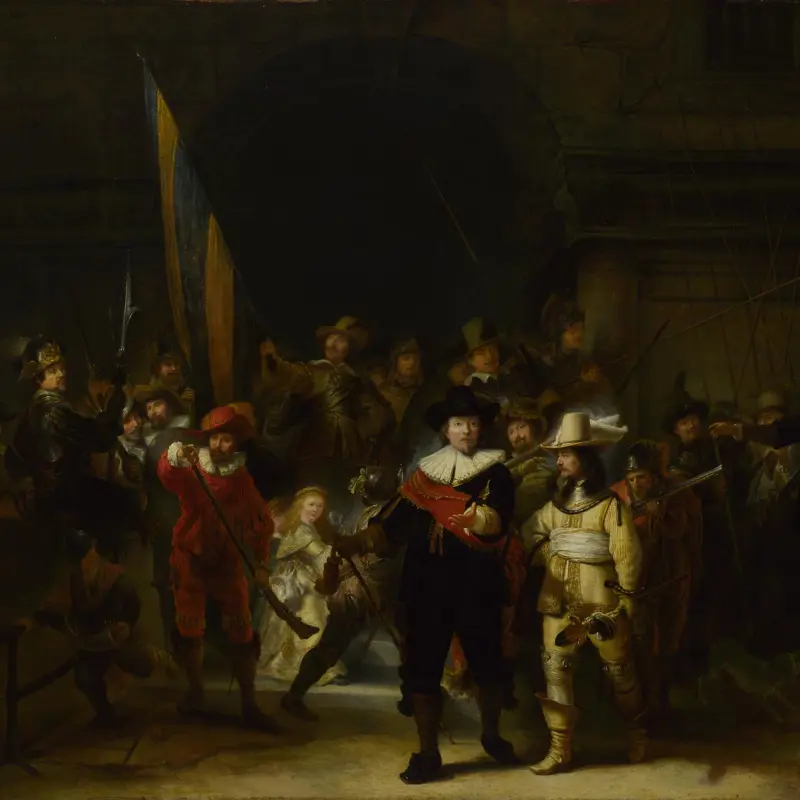Rembrandt, 'Portrait of Frederick Rihel on Horseback', about 1663
About the work
Overview
This is one of the largest paintings ever made by Rembrandt, and one of only two life-size equestrian portraits of ordinary citizens in the history of Dutch art. The rider has been identified as the prosperous businessman Frederik Rihel. His bright yellow jerkin, fancy gloves, shimmering sleeves and plumed hat stand out radiantly against the rather gloomy, sketchy background.
Despite the gloom, it’s possible to make out parts of a procession winding around a stretch of water behind Rihel. On the left is the facade of one of the gates to the city of Amsterdam, and in front of this is a coach with a bright red and yellow interior carrying three passengers. In the right background there are two (or possibly three) riders on horseback. This probably represents the procession accompanying the entry of Prince William of Orange into Amsterdam in 1660, in which Rihel participated as one the Amsterdam Guard of Honour.
Key facts
Details
- Full title
- Portrait of Frederick Rihel on Horseback
- Artist
- Rembrandt
- Artist dates
- 1606 - 1669
- Date made
- about 1663
- Medium and support
- oil on canvas
- Dimensions
- 294.5 × 241 cm
- Inscription summary
- Signed; Dated
- Acquisition credit
- Bought with a special grant and contributions from the Art Fund and The Pilgrim Trust, 1959
- Inventory number
- NG6300
- Location
- Not on display
- Collection
- Main Collection
Provenance
Additional information
Text extracted from the ‘Provenance’ section of the catalogue entry in Neil MacLaren, revised and expanded by Christopher Brown, ‘National Gallery Catalogues: The Dutch School: 1600–1900’, London 1991; for further information, see the full catalogue entry.
Exhibition history
-
2014Rembrandt: The Late WorksThe National Gallery (London)15 October 2014 - 18 January 2015Rijksmuseum Amsterdam12 February 2015 - 17 May 2015
Bibliography
-
1829
J. Smith, A Catalogue Raisonné of the Works of the Most Eminent Dutch, Flemish, and French Painters: In Which is Included a Short Biographical Notice of the Artists, with a Copious Description of Their Principal Pictures […], 9 vols, London 1829-1842
-
1833J.D. Passavant, Kunstreise durch England und Belgien, Frankfurt am Main 1833
-
1854G.F. Waagen, Treasures of Art in Great Britain: Being and Account of the Chief Collections of Paintings, Drawings, Sculptures, Illuminated Mss. […], vol. 2, trans. E. Eastlake, London 1854
-
1877C. Vosmaer, Rembrandt: Sa vie et ses oeuvres, La Haye 1877
-
1893É. Michel, Rembrandt, sa vie, son oeuvre et son temps, Paris 1893
-
1897W. von Bode and C. Hofstede de Groot, The Complete Work of Rembrandt, 8 vols, Paris 1897
-
1907C. Hofstede de Groot, Catalogue Raisonné of the Works of the Most Eminent Dutch Painters of the Seventeenth Century, 10 vols, London 1907
-
1907C. Hofstede de Groot, Catalogue Raisonné of the Works of the Most Eminent Dutch Painters of the Seventeenth Century, 10 vols, London 1907
-
1910A. Bredius, 'Rembrandtiana', Oud Holland, XXVIII/4, 1910, pp. 193-204
-
1953H. Honour, 'An Equestrian Portrait by Rembrandt', Leeds Art Calendar, 1953, pp. 7-11
-
1953J.G. van Gelder, 'Rembrandt and His Circle', The Burlington Magazine, XCV/599, 1953, pp. 34-9
-
1957R. Luttervelt, 'De Grote Ruiter van Rembrandt', Nederlands Kunsthistorisch Jaarboek, VIII, 1957, pp. 185-219
-
1958I.H. Eeghen, 'Frederick Rihel een 17de eeuwse zakenman en paardenliefhebber', Amstelodamum, XLV, 1958, pp. 73-81
-
1958R. Luttervelt, 'Frederick Rihel or Jacob de Graeff', Amstelodamum, XLV, 1958, pp. 147-50
-
1960The National Gallery, The National Gallery: July 1958 - December 1959, London 1960
-
1988D. Bomford et al., Rembrandt (exh. cat. The National Gallery, 12 October 1988 - 17 January 1989), London 1988
-
1988J. Bruyn, Een gloeiend palet: Schilderijen van Rembrandt en zijn school (exh. cat. Museum Boijmans Van Beuningen, 6 November 1988 - 15 January 1989), Rotterdam 1988
-
1989J. Mills and R. White, 'Paint Media Analyses', National Gallery Technical Bulletin, XIII, 1989, pp. 69-71
-
1990J. Bruyn, 'An Unknown Assistant in Rembrandt's Workshop in the Early 1660's', The Burlington Magazine, CXXXII/1051, 1990, pp. 715-8
-
1991Maclaren, Neil, revised by Christopher Brown, National Gallery Catalogues: The Dutch School, 1600-1900, 2nd edn (revised and expanded), 2 vols, London 1991
-
1991J. Held, 'The Polish Rider', in J. Held, Rembrandt Studies, Princeton 1991, pp. 59-98
-
1993C. Tümpel, Rembrandt: All Paintings in Colour, Antwerp 1993
-
1993S.A.C. Dudok van Heel, 'Rembrandt en de vaandrigs van de Amsterdamse schutterij. Diende Rembrandts "vaandeldrager" uit 1636 als "modello"?', Kroniek van het Rembrandthuis, II, 1993, pp. 15-24
-
1994M. Jaffé, 'Abraham's Sacrifice: A Rembrandt of the 1660's', Artibus et historiae, XV/30, 1994, pp. 193-210
-
2001
C. Baker and T. Henry, The National Gallery: Complete Illustrated Catalogue, London 2001
About this record
If you know more about this work or have spotted an error, please contact us. Please note that exhibition histories are listed from 2009 onwards. Bibliographies may not be complete; more comprehensive information is available in the National Gallery Library.

